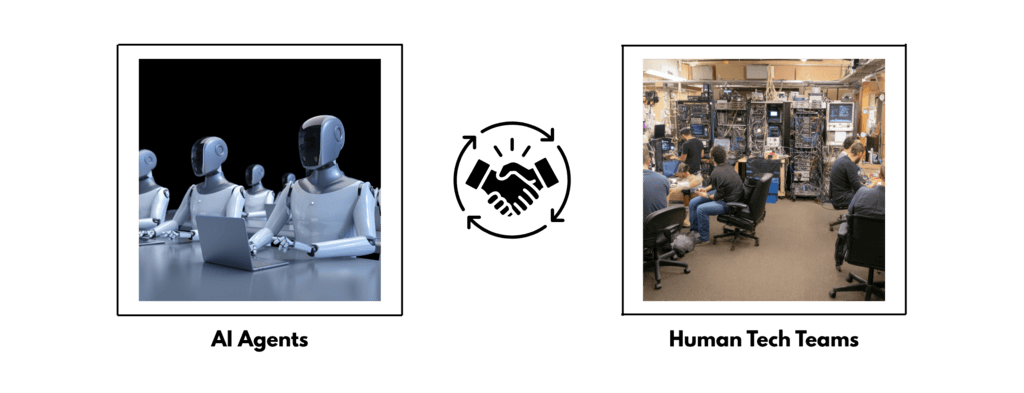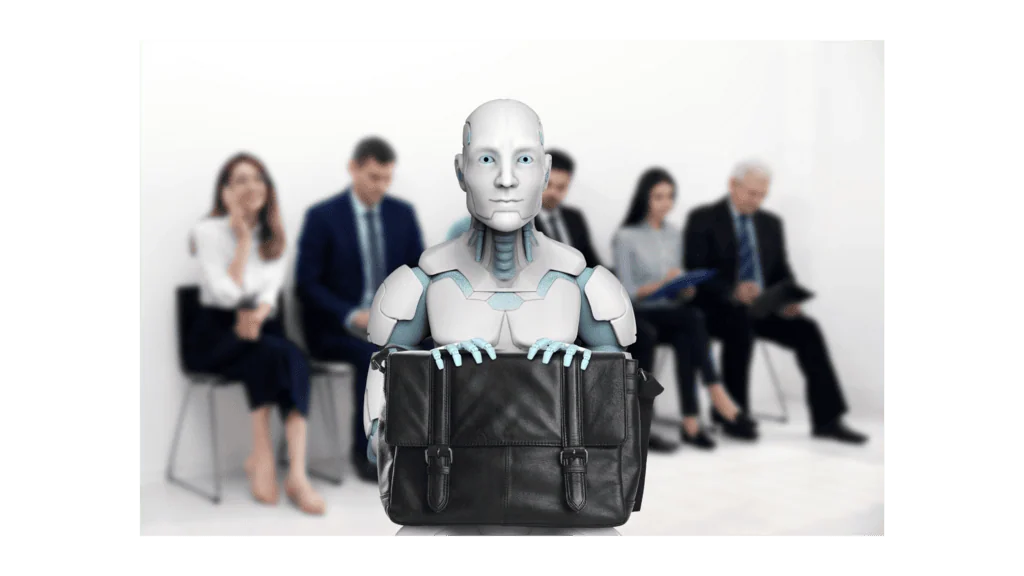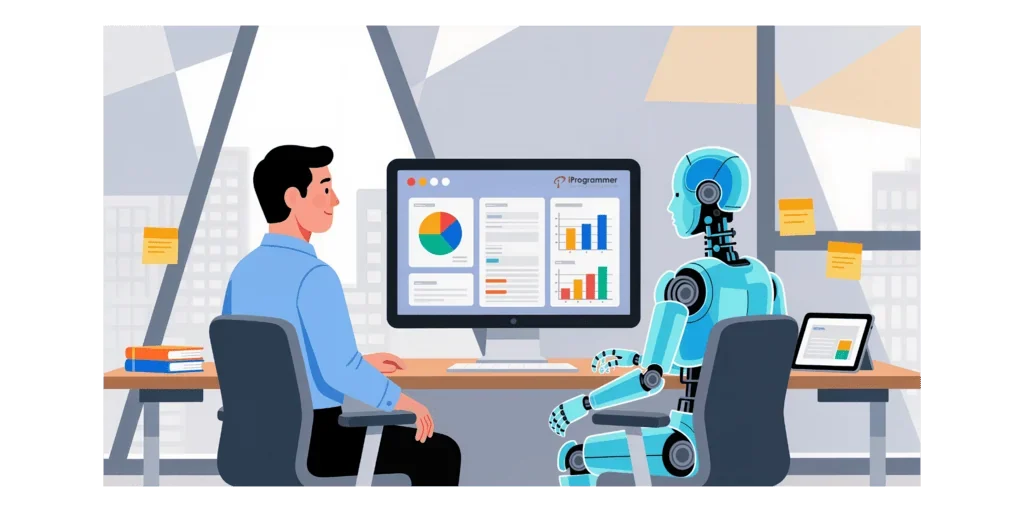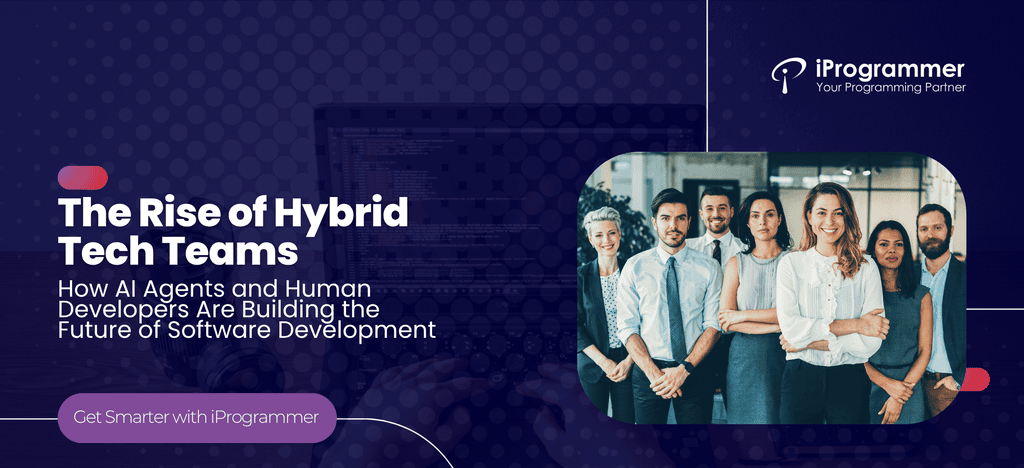The Rise of Hybrid Tech Teams: Redefining Development with AI Staff Augmentation
-
- From Automation to Collaboration: How We Got Here
- What Exactly Are AI Agents?
- The Hybrid Tech Team Model
- IT Staff Augmentation 2.0: The Rise of AI-Augmented Workforce
- Operational Dynamics: How Humans and AI Co-Create
- Why Enterprises Are Moving Toward Hybrid Teams
- Challenges and Considerations
- Implementing a Hybrid Team Strategy
- The Future of Hybrid Tech Teams
- Takeaway
- About iProgrammer: Pioneering the Future of Hybrid Teams
Software development has always evolved through waves of transformation, from mainframes to microservices, from on-premise code to cloud-native ecosystems. Yet, every transformation so far has centred around humans. Developers wrote, tested, deployed, and maintained. Tools assisted, but they never truly collaborated.
That equation is slowly changing.
Across industries, the next-generation software team is taking shape. One where AI agents work alongside human developers as active contributors. These agents don’t just suggest lines of code but also interpret requirements, review commits, generate documentation, and even propose architectural solutions.
It’s the early architecture of what we call Hybrid Tech Teams — blended teams where people and intelligent agents operate as peers within the same delivery pipeline.
For decision-makers, this revolutionizes the way software is built, scaled, and maintained. The future is one of harmonizing intelligence — human and artificial — to make technology development quicker, brighter, and more robust than ever.
From Automation to Collaboration: How We Got Here
The evolution toward hybrid teams began years ago, long before the first AI coding assistant appeared. It started with the automation of repetitive development tasks like CI/CD pipelines, testing frameworks, infrastructure as code.
Then came assistive tools — linting, syntax auto-completion, code analysers, that optimized human effort without altering its structure. They made developers faster, not different.
But the turning point arrived with AI-powered copilots. These systems began to understand context, learn from repositories, and generate functionally relevant code. The developer’s role subtly shifted from pure creation to orchestration and supervision.
Now, a new class of systems — AI agents has entered the workspace. In contrast to rule-based automation, these agents are autonomous entities capable of reasoning, planning, and taking action. They are able to analyse a ticket for a problem, break it down into tasks, code, test outcomes, and also create pull requests.
In parallel, the business side of technology staffing was transforming. IT staff augmentation — once a matter of scaling manpower — began to evolve into a more sophisticated model: augmenting capability.
Hybrid teams are the natural convergence of these two trajectories. The intelligence of AI agents meets the creativity of human engineers, under a staffing model built for adaptability. This isn’t the future arriving; it’s the past completing its arc.
What Exactly Are AI Agents?
AI agents are autonomous software systems that can conduct multi-step tasks in dynamic settings. They are different from legacy automation since they work with awareness of context, learning capabilities, and decision independence.
In software development, these agents can:
- Review and refactor legacy codebases.
- Generate functional modules based on natural-language prompts.
- Automate regression tests and build validations.
- Oversee infrastructure and conduct root-cause investigations on incidents.
In contrast to fixed AI tools, agents develop through data and experience. They interact with repositories, version control systems, and communication tools. They can respond to queries in real time, summarize documentation, or trigger deployments — all under defined governance rules.
The promise is speed with continuity. AI agents don’t forget context, don’t take breaks, and don’t lose knowledge across transitions. They preserve institutional memory, a subtle but profound advantage in an industry defined by attrition and turnover.
Yet, their full potential emerges only when they are embedded into human teams — where logic meets judgment, and automation meets empathy.
The Hybrid Tech Team Model

A Hybrid Tech Team blends human creativity with machine efficiency. It’s not a hierarchy of tools and people, but a partnership of complementary intelligence.
At its core, a hybrid team might include:
- Developers and data engineers who design and review logic.
- QA specialists who validate outcomes.
- DevOps professionals managing pipelines.
- Product leads aligning vision and priorities.
- AI agents integrated across all layers — coding assistants, testing bots, documentation generators, and observability monitors.
The workflow becomes bi-directional. Humans guide context; agents handle execution and repetition. Developers move from code producers to solution architects. Managers shift from resource allocators to intelligence orchestrators.
The result is faster delivery cycles, fewer errors, and teams that can operate at enterprise scale without exponential headcount growth.
But hybrid teams are not a plug-and-play idea. They require cultural and operational rethinking. Trust must be redistributed, not away from humans, but to learning and co-creative systems.
IT Staff Augmentation 2.0: The Rise of AI-Augmented Workforce

Legacy staff augmentation enabled businesses to scale engineering capacity without new hires. It was about time zones, skill sets, and resource flexibility.
Today, that logic alone is insufficient. Projects demand not just more developers — but more intelligent capacity. The AI-augmented workforce bridges this gap.
Imagine a team where a new member, an AI agent, joins on day one already trained on your codebase. It can review your repository history, suggest consistent naming conventions, flag outdated dependencies, or generate documentation automatically.
In this Staff Augmentation 2.0 model, augmentation extends beyond people. It’s about augmenting performance, scaling velocity without scaling complexity. ore organizations now explore the option to hire AI agents alongside developers — not as replacements, but as intelligent collaborators that expand team capability from day one.
For enterprises, the advantages are tangible:
- Reduced onboarding time: Agents quickly acquire knowledge from data; new human participants adjust more rapidly with AI-generated insights.
- Continuous productivity: Agents function continuously, guaranteeing no interruptions in testing or implementation.
- Data-backed governance: AI agents preserve comprehensive activity logs, guaranteeing compliance and audit readiness.
- Operational scalability: Hybrid teams can increase output capacity without adding organizational tiers.
Integrating AI agents into human teams isn’t a technical integration problem. It’s a workflow design challenge. Success depends on rethinking how decisions, tasks, and accountability flow.
A well-orchestrated hybrid team functions in synchronized loops:
- Planning:
AI agents analyse past sprints, identify blockers, and generate draft task lists or effort estimates. Humans validate and refine priorities. - Coding:
Developers write the architectural core. Agents handle repetitive constructs, generate test cases, and enforce coding standards through automated reviews. - Testing:
Agents execute regression and load tests autonomously. QA engineers focus on usability and experiential validation — the parts that require human judgment. - Deployment:
Agents initiate CI/CD pipelines, oversee build integrity, and automatically revert in the event of irregularities. - Maintenance:
Agents monitor system metrics, identify anomalies, and suggest fixes. Humans validate impact and approve production pushes.
This co-creation loop changes what productivity means. Instead of measuring hours logged, organizations measure outcomes achieved. Rather than people operating alone, teams act as flexible ecosystems of intelligence.
Why Enterprises Are Moving Toward Hybrid Teams

The argument for hybrid teams is no longer theoretical. Enterprises adopting them report measurable impact.
- Acceleration: Projects move faster because routine work compresses. AI agents reduce debugging and testing cycles by as much as 40%.
- Quality: Agents enforce consistency, identify vulnerabilities early, and enable continuous code improvement.
- Resilience: Knowledge continuity minimizes disruption from turnover. Agents preserve project memory across transitions.
- Optimization: Developers concentrate on tasks with significant impact, while automation manages repetitive efforts.
- Scalability: Teams increase output without raising costs or management burdens.
This framework also alters the way businesses view outsourcing. Rather than increasing the workforce to adhere to delivery schedules, they can create AI-driven development teams that produce greater results per engineer.
For decision-makers, the implication is tactical: productivity is not limited by the number of developers, but by the complexity of the hybrid environment.
Just as DevOps transformed the alignment between development and operations, hybrid teams are reshaping the connection between intelligence and execution.
Challenges and Considerations
Every evolution carries complexity. Incorporating AI agents into development teams necessitates intentional governance and careful design.
Accountability: Who is accountable for the choices made by an AI agent? Organizations need to create distinct oversight systems in which humans are the ultimate decision-makers.
Transparency: Code produced by AI should be able to be traced and clarified. Unquestioning faith brings danger; organized verification guarantees security.
Data Sensitivity: Utilizing agents for training or operations on proprietary code requires robust access controls and secure environments.
Cultural Readiness: Hybrid teams excel in environments that promote experimentation. Teams used to linear workflows may initially resist shared autonomy.
Skill Transition: Developers must learn to collaborate with AI — prompting, validating, and refining outputs effectively.
When addressed with foresight, these challenges don’t hinder progress — they define maturity. Organizations that thrive will be the ones that view AI agents not as mere novelties but as new team members needing guidance, ethical considerations, and support.
Implementing a Hybrid Team Strategy
Enterprises curious about hybrid teams often ask where to begin. The journey doesn’t start with tools — it starts with intent.
- Identify Value Zones:
Not every part of a development lifecycle benefits equally from AI. Start with high-volume, low-judgment areas — testing, code review, documentation. - Redefine Roles:
Establish hybrid structures early. For example, a “Human + AI” QA pair where the agent performs regression testing while the human validates UX nuances. - Reimagine Metrics:
Move beyond hours and tickets. Track metrics like iteration velocity, bug recurrence, and review turnaround. These reveal the real gains from AI augmentation. - Build Governance:
Adopt explainable AI practices. Ensure every AI-driven decision — from code generation to deployment — is auditable. - Upskill Continuously:
Hybrid teams demand new skills: prompt design, AI debugging, and multi-agent coordination. Train teams early to lead, not react. - Partner Intelligently:
Hybrid transformation isn’t a plug-in exercise. It requires a partner who understands both human engineering culture and AI orchestration.
The Future of Hybrid Tech Teams
We are still in the early stages of this change, yet the direction is clear. In the coming years, AI agents in software development will transition from assisting roles to taking on leadership positions in particular domains. They will manage micro-sprints, handle test cycles end-to-end, and integrate analytics directly into codebases.
Human developers, freed from mechanical repetition, will focus on architecture, innovation, and problem definition — the creative frontier of software.
IT staff augmentation will evolve into intelligence augmentation, where clients won’t just hire developers — they’ll subscribe to outcome-driven hybrid pods combining humans and AI entities.
As these ecosystems develop, organizations will distinguish themselves not by the scale of their engineering teams, but by the complexity of their hybrid collaboration model. Success will belong to those who excel in co-intelligence — a realm where the combined abilities of humans and machines exceed what either could accomplish independently.
Every few decades, software development reaches a point that irreversibly alters its course. The rise of hybrid teams is one such moment.
The shift isn’t about automation. It’s about amplification. Employing AI agents to improve the accuracy, rapidity, and scalability of human cognition.
For product leaders, this involves reevaluating team structure, oversight, and values. For developers, it means evolving from coders to conductors of intelligence.
The hybrid workforce isn’t an idea for the future; it’s simply the next logical step in digital evolution. Those who adopt it early will shape the speed and style of innovation in the next ten years.
At iProgrammer, we believe technology is most powerful when it’s human at its core and intelligent in its execution. For over a decade, we’ve helped enterprises and startups build, scale, and evolve digital teams that deliver measurable value.
Today, our focus extends beyond talent/IT staff augmentation or into AI-integrated team orchestration. We enable clients to combine skilled engineers with autonomous AI agents, building systems that are adaptive, secure, and performance driven.
Our experience across web, mobile, AI, and enterprise systems allows us to design solutions that evolve with your business. Whether you’re exploring AI staff augmentation, looking to hire AI agents as part of your next development initiative, or seeking a partner who understands the future of software delivery, we bring clarity, capability, and confidence. The future belongs to teams that collaborate with intelligence. At iProgrammer, we can help you build them.









